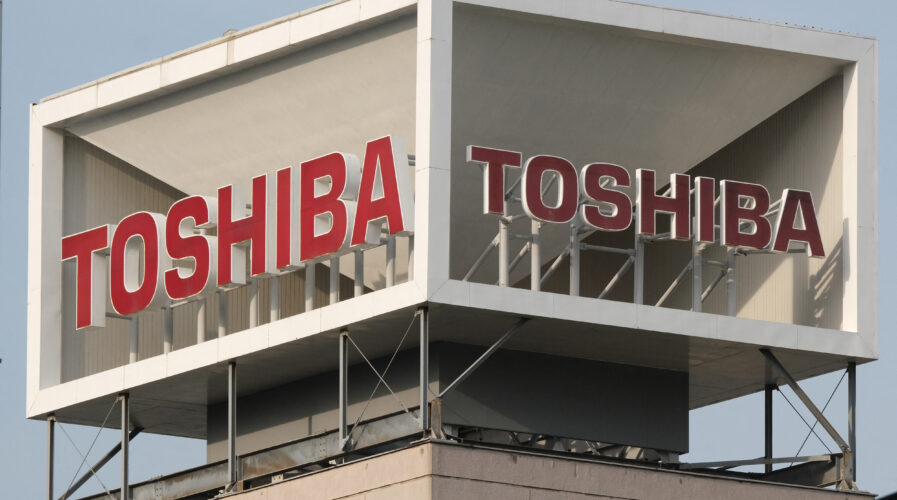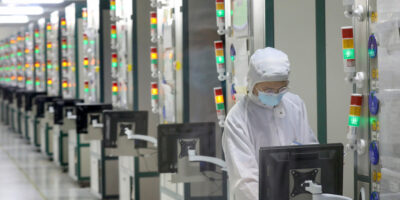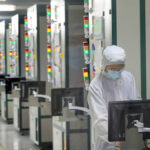
(Photo by Kazuhiro NOGI / AFP)
Toshiba to build wafer fabrication facility for power semiconductors
- Toshiba to construct a new 300-millimeter wafer fabrication facility for power semiconductors.
- The plant will be constructed at its main discrete semiconductor production base, Kaga Toshiba Electronics Corporation, in Ishikawa Prefecture.
- The new fab is expected to increase Toshiba’s power semiconductor production capacity by 2.5 times that of fiscal 2021.
Demand for semiconductors, especially in wafer fabrication was one of the biggest reasons why the chip shortage affected many manufacturers in 2021. Wafer fabrication is the process to produce a complete electrical circuit on semiconductor wafers. From vehicles to mobile devices, these components are used in nearly all modern products.
According to a research report, the global water fabrication market is expected to grow to US$ 62 billion by 2025 with the Asia Pacific dominating the global wafer fabrication market. Yet, despite the presence of major semiconductor manufacturers in the region, the demand is still more than the supply.
As such, Toshiba Electronic Devices & Storage Corporation has announced the construction of a new 300-millimeter wafer fabrication facility for power semiconductors at its main discrete semiconductor production base, Kaga Toshiba Electronics Corporation, in Ishikawa Prefecture.
The construction will take place in two phases, allowing the pace of investment to be optimized against market trends, with the production start of Phase 1 scheduled for within fiscal 2024. When Phase 1 reaches full capacity, Toshiba’s power semiconductor production capacity will be 2.5 times that of fiscal 2021.
Toshiba is already ranked as the top 10 capacity leaders in the 100-millimeter and 200-millimeter production among semiconductor producers globally. To date, Toshiba has met this demand growth by increasing production capacity on 200-millimeter lines and expediting the start of production on 300-millimeter production lines from the first half of fiscal 2023 to the second half of fiscal 2022.
With power devices being essential components for managing and reducing power consumption in every kind of electronic equipment, achieving a carbon-neutral society is key. Current demand is expanding on vehicle electrification and the automation of industrial equipment, with very strong demand for low-voltage MOSFETs (metal-oxide-semiconductor field-effect transistors) and IGBTs (insulated-gate bipolar transistors), and other devices.
In November last year, Toshiba also announced that it will split its core operations into two new companies, one being for infrastructure services while the other for technology devices. The remaining business will hold its stake in memory chip pioneer Kioxia Holdings and Toshiba Tec Corp. The aim was to complete the spinoffs by the second half of 2023.
Toshiba also announced that decisions on the new fab’s overall capacity and equipment investment, the start of production, production capacity, and production plan will reflect market trends.
The new fab will have a quake absorbing structure; enhanced BCP systems, including dual power supply lines; and the latest energy-saving manufacturing equipment to reduce environmental burdens. It will also aim to achieve the “RE100” goal of 100% reliance on renewable energy. Product quality and production efficiency will be improved by introducing artificial intelligence and automated wafer transportation systems.
Toshiba also plans to expand its power semiconductor business and boost competitiveness by timely investments and research and development that will allow it to respond to fast-growing demand and to contribute to a low-energy society and carbon neutrality.
READ MORE
- Ethical AI: The renewed importance of safeguarding data and customer privacy in Generative AI applications
- How Japan balances AI-driven opportunities with cybersecurity needs
- Deploying SASE: Benchmarking your approach
- Insurance everywhere all at once: the digital transformation of the APAC insurance industry
- Google parent Alphabet eyes HubSpot: A potential acquisition shaping the future of CRM


